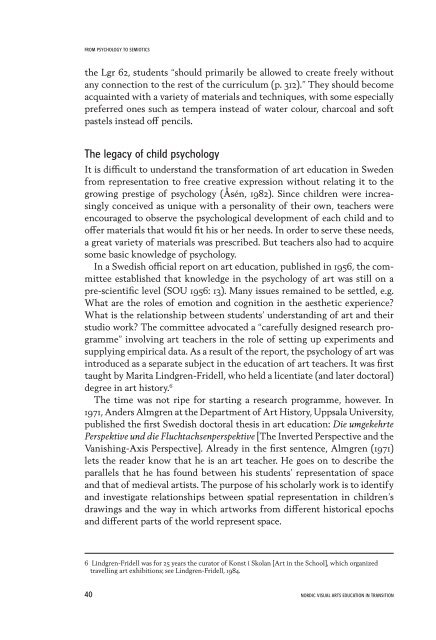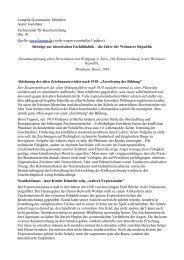Research in Visual Arts Education - The National Society for ...
Research in Visual Arts Education - The National Society for ...
Research in Visual Arts Education - The National Society for ...
You also want an ePaper? Increase the reach of your titles
YUMPU automatically turns print PDFs into web optimized ePapers that Google loves.
FROM PSYCHOLOGY TO SEMIOTICS<br />
the Lgr 62, students “should primarily be allowed to create freely without<br />
any connection to the rest of the curricu l um (p. 312).” <strong>The</strong>y should become<br />
acqua<strong>in</strong>ted with a variety of materials and techniques, with some especial ly<br />
preferred ones such as tempera <strong>in</strong>stead of water colour, charcoal and soft<br />
pastels <strong>in</strong>stead off pencils.<br />
<strong>The</strong> legacy of child psychology<br />
It is difficult to understand the trans<strong>for</strong>mation of art education <strong>in</strong> Sweden<br />
from represen tation to free creative expression without relat<strong>in</strong>g it to the<br />
grow<strong>in</strong>g prestige of psycho logy (Åsén, 1982). S<strong>in</strong>ce children were <strong>in</strong>creas<strong>in</strong>gly<br />
conceived as unique with a personality of their own, teachers were<br />
encouraged to observe the psychological development of each child and to<br />
offer materials that would fit his or her needs. In order to serve these needs,<br />
a great variety of materials was prescribed. But teachers also had to acquire<br />
some basic knowledge of psy chology.<br />
In a Swedish official report on art education, published <strong>in</strong> 1956, the committee<br />
estab lished that knowledge <strong>in</strong> the psychology of art was still on a<br />
pre-scientific level (SOU 1956: 13). Many issues rema<strong>in</strong>ed to be settled, e.g.<br />
What are the roles of emotion and cognition <strong>in</strong> the aesthetic experience<br />
What is the relationship between students’ understand<strong>in</strong>g of art and their<br />
studio work <strong>The</strong> committee advocated a “carefully designed research programme”<br />
<strong>in</strong>volv<strong>in</strong>g art teach ers <strong>in</strong> the role of sett<strong>in</strong>g up experiments and<br />
supply<strong>in</strong>g empirical data. As a result of the re port, the psychology of art was<br />
<strong>in</strong>troduced as a separate subject <strong>in</strong> the educa tion of art teach ers. It was first<br />
taught by Marita L<strong>in</strong>dgren-Fridell, who held a licentiate (and later doctoral)<br />
degree <strong>in</strong> art history. 6<br />
<strong>The</strong> time was not ripe <strong>for</strong> start<strong>in</strong>g a research programme, however. In<br />
1971, Anders Almgren at the De part ment of Art History, Uppsala University,<br />
published the first Swed ish doctoral thesis <strong>in</strong> art education: Die umgekehrte<br />
Perspektive und die Flucht achsen perspektive [<strong>The</strong> Inverted Perspective and the<br />
Vanish<strong>in</strong>g-Axis Perspec tive]. Already <strong>in</strong> the first sentence, Almgren (1971)<br />
lets the reader know that he is an art teacher. He goes on to de scribe the<br />
parallels that he has found between his students’ representation of space<br />
and that of me die val artists. <strong>The</strong> purpose of his scholarly work is to identify<br />
and <strong>in</strong>vestigate relation ships between spatial representation <strong>in</strong> children’s<br />
draw <strong>in</strong>gs and the way <strong>in</strong> which artworks from different historical epochs<br />
and different parts of the world represent space.<br />
6 L<strong>in</strong>dgren-Fridell was <strong>for</strong> 25 years the curator of Konst i Skolan [Art <strong>in</strong> the School], which organized<br />
travell<strong>in</strong>g art exhibitions; see L<strong>in</strong>dgren-Fridell, 1984.<br />
40 NORDIC VISUAL ARTS EDUCATION IN TRANSITION



